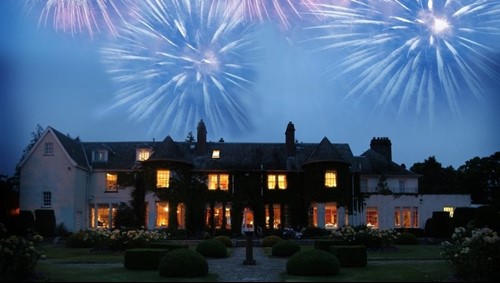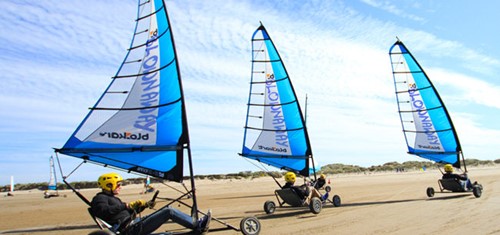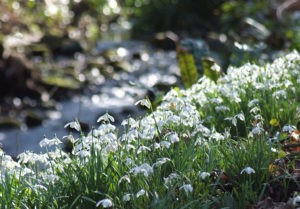
A new year calls for new adventures. This New Year (and new decade) presents an opportunity to make good on all those broken promises to travel. Find the perfect activity or place to visit from our top 20 to put on your Fife bucket list!
1. Play a round of golf on the Old Course
The Old Course at St Andrews Links is where the game was first played 600 years ago, and it’s easier to obtain a tee time than you might think. If you have a suitable handicap (maximum of 24 for men and 36 for women), half of Old Course tee times each year are allocated to the ballot to give people who have been unable to book a chance of playing. It is drawn 48 hours in advance of play and golfers should provide their names, home club and handicaps either online, by phone or at one of the clubhouses before 2pm, two days before the day they wish to play. To enter there must be a minimum of two and a maximum of four players.
2. British Golf Museum
Staying with golf, from the 16th century to the present day, the whole history of the great game is explored under one roof at the British Golf Museum in St Andrews. Discover the equipment, personalities and prizes of this much loved sport. Brought to life with hands on activities, interactives and modern interpretation, this is a must see attraction. The flagship exhibition space, ‘The Open Gallery’, explores the rich history of golf’s oldest Major.
3. Eden Mill
In 1810 the Eden Estuary was offering its crystal clear waters to the legendary Haig brothers, helping them distil and lay down some of St Andrews’ finest whiskies. Before them this same site hosted the Seggie Brewery. In 2012, Eden Mill resurrected this brewing and spirits tradition with its own take on Scottish craft brewing and distilling and were Scotland’s first single site brewery and distillery. Its distillers are at the forefront of experimental wood ageing and distillation methods and visitors can enjoy gin tastings at the Blendworks Gin School in St Andrews.
4. St Andrews Cathedral
Explore the remains of Scotland’s largest and most magnificent medieval church. Even in its ruinous state, the cathedral remains a prominent St Andrews landmark highly visible from the sea. You can find out how the cathedral dominated Scottish religion until 1560, as headquarters of the medieval Scottish Church and if you have a head for heights you can climb to the top of the 33m tall St Rule’s Tower for spectacular views across Fife.
5. West Sands
Located on the eastern coastline of the Kingdom of Fife, West Sands is famous for the opening scenes of the film Chariots of Fire and extends for almost 2 miles of uninterrupted sand backed dunes. Popular throughout the year for walking and running, West Sands is best-enjoyed in the summer months, when it becomes a hive of activity for water-sports enthusiasts and beach-based adventures such as land-yachting.

The colourful land yacht on West Sands Beach
6. The Swilcan Bridge
Have your photograph taken at the iconic small stone bridge on the St Andrews Links golf course. The bridge spans the Swilcan Burn between the first and eighteenth fairways on the Old Course, and has become an important cultural icon in the sport of golf. Originally built at least 700 years ago to help shepherds get livestock across, it has the modern photographic advantage of great backdrops on three sides: the course’s grand Royal and Ancient Clubhouse and Hamilton Hall on one, often a packed grandstand of enthusiasts on another, and rolling hills facing toward the North Sea, on the last.
7. St Andrews Castle
Explore a castle caught in the Protestant Reformation struggle. St Andrews Castle was a bishop’s palace, a fortress and a state prison during its 450-year history. Peer into the bottle dungeon – one of medieval Britain’s most infamous castle prisons where it is thought Protestant preacher George Wishart may have been imprisoned in the castle’s bottle dungeon and Cardinal Beaton’s murdered body was certainly kept in the dank and airless hole. The assassination sparked the brutal siege of 1546–47, when opposing sides dug the remarkable mine and countermine into the rock close to the castle battlements.
8. Fife Coastal Path
With the Kincardine Bridge and the Tay Bridge at either end, the Fife Coastal Route traces a meandering path along the glittering Firth of Forth coastline, passing places such as the Royal Burgh of Culross, the beautiful fishing towns in the East Neuk and historic St Andrews. It’s a car free tour along some of the Kingdom’s prettiest shoreline using buses to access individual sections. Each path section lists the distance and approximate time to complete, along with information on what to see en-route. If you have a specific interest, you can use an interactive map to highlight the areas of the path that are best suited to you to really personalise your experience.
9. Fife Pilgrim Way
Officially opened in July 2019, a new long distance walking route that brings the northern and southern edges of Fife together is the 64 mile (104 km) Fife Pilgrim Way. The path takes the walker on a journey through history as it winds its way through the ancient Kingdom reflecting upon the days when Fife was the one the many religious destinations within Scotland for pilgrims between the 11th to 16th centuries. The modern day route follows some of the region’s ancient pathways and gives the walker a chance to walk in the footsteps of these medieval travellers. Walkers can choose to begin their adventure through time from one of two stunning locations on the shores of the Firth of Forth. The choice between the beautiful coastal village of Culross or the equally pretty North Queensferry will be a tough choice to make but no matter where you begin, you will be sure to have a memorable experience.
10. Craigtoun Country Park
Has been open to visitors since the 19th century, featuring sprawling gardens and a number of attractions. Spend a day in the park when the sun is out or bring along a picnic. Stop by Puffin’ Billy, the vintage tractor on show, or take a ride on the miniature railway. There is also a Dutch Village with pedalos and rowing boats available for hire along the adjoining lake.
11. Cambo Gardens
Cambo Estate lies on the east coast of Fife, 7 miles south of St Andrews. The present day estate, which has been in the Erskine family for over 300 years, dates from the late 18th and early 19th centuries. Meander through magical gardens and woodlands to an award-winning beach, or browse plants, fresh flowers and local crafts in the Tack Room shop. Enjoy our heritage exhibition. There is lots to do for the whole family and activities throughout the year. Don’t miss the snowdrop festival in February and March when thousands of snowdrops carpet the woodlands.

The Snowdrop Festival is not to be missed in 2021!
12. University of St Andrews
Founded in 1413, the university forms the centre of St. Andrews. It’s the smallest and oldest of Scotland’s seats of learning and makes for a fun walkabout thanks to its well-preserved old architecture. The Colleges of St. Salvator (1450) and St. Leonard (1511) were combined in 1747 and are devoted to Arts and Sciences, while St. Mary’s College, opened by Cardinal Beaton in 1538, serves as the theology faculty. The College Chapel in St. Salvator contains the pulpit from Holy Trinity Church, where reformer John Knox first preached. St. Leonard’s Chapel houses some fine tombstones from the 16th and 17th centuries and is certainly worth a visit. Make sure you save time for its museums too; the Bell Pettigrew Museum (notable for its natural history collections), the contemporary art exhibits in the Gateway Galleries and the Museum of the University of St Andrews (MUSA) – a free museum displaying some of the amazing treasures from the University’s collection of over 112,000 artefacts. The Museum is located on the Scores in St Andrews and is home to St Salvator’s Mace, which is still used in Graduation and Welcome ceremonies. The museum has four galleries, a ‘Learning Loft’ and a viewing terrace with stunning panoramic views over St Andrews Bay. MUSA is family friendly and its galleries feature a number of fun hands-on interactives as well as an art cart which is full of creative activities for children from dressing up to drawing.
13. Hill of Tarvit
Discover a fascinating record of upstairs and downstairs life in an Edwardian mansion. You can view the fabulous Sharp Collection, which includes paintings, tapestries and ceramics or get stuck into period parlour games. In the summer months visitors can enjoy croquet on the lawn or tee off at Kingarrock Golf Course, an original 9 hole hickory club course.
14. St Andrews Botanic Garden
St Andrews Botanic Garden is a national treasure in the heart of St Andrews where you can discover a haven of rare and unusual plants. Enjoy ponds, waterfalls, rock gardens, herbaceous borders and woodland walks. Over 2000 square metres of heated glasshouses protect cacti and large collections of tropical plants and alpines. St Andrews Botanic Garden also holds a globally important botanic collection and is a centre for botanical knowledge. They use a diverse plant collection and expertise to promote and advance the education of diverse communities in the knowledge of botany, horticulture, the environment and other subjects related to the work carried out at the garden.
15. Isle of May National Nature Reserve
Visit the Isle of May to connect with the beautiful wildlife and nature of Fife. The island is a roosting ground for seabirds, including puffins, razorbills and cormorants. You can even spot grey seals in the winter! It’s the perfect place to witness some local flora and fauna, including rabbits, butterflies and gorgeous flowers. The island has a fascinating history and is home to an early secluded monastery and Scotland’s first ever lighthouse. Visit the monuments on this little island to learn more about the history of the Isle of May.
16. The Scottish Deer Centre
Set in the Fife countryside covering over 55 acres, their collection includes 12 species of deer and animals which are long lost from the Scottish countryside including wolves, lynx and Scottish wildcat plus the European brown bear. Open all year round you can learn about the animals with daily feeding talks, tours and falconry shows or enjoy play areas inside and out for younger visitors.
17. Tentsmuir Forest
A beachside pine forest, with miles of trails and lots of wartime heritage and wildlife to explore. The forest is perfect for exploring either by foot or bike, following one of the way-marked trails or the longer circular route. Tentsmuir is also home to wildlife with everything from roe deer to red squirrels. If you walk further along the beach to Tentsmuir Point there is also a good chance you will see hundreds of seals basking on the sandbars.
18. Falkland Palace
One of the grandest and most beautiful places to visit in Fife, Falkland Palace has stood on the same site since the 12th century, when it was originally a hunting lodge. Over the years it has been expanded and improved, and today much of the palace has been carefully restored, whilst other areas feature ruins. Originally used as a home for Scottish monarchs including Mary, Queen of Scots it is now a museum and gardens for visitors to enjoy. You can find antique furniture, gorgeous tapestries and stunning painted ceilings within the palace. In the gardens, you can visit the oldest royal tennis court in the UK, as well as orchards, flower gardens and the Falkland Castle ruins.
19. Aberdour Castle
Is one of the oldest standing castles in Scotland, dating from 1200. The castle was home to a number of noble families over the centuries. Today, the castle is made up of buildings and ruins which showcase how the castle was built on and improved since the original construction. The castle features galleries, painted ceilings and a restored medieval church. In the grounds you will find beautiful walled gardens full of fragrant flowers, and plenty of manicured lawns to walk along. Book a guided tour to learn more about the history of Aberdour Castle, or eat local food at the café which overlooks the gardens. Aberdour Castle is a pristine and peaceful place to visit in Fife.
20. The Fife Folk Museum
Is the best place in the county to learn about traditional local life and heritage. The museum holds a large collection of items documenting rural life in Fife, including a restored tollbooth from 1673 and a traditional weigh-house. The museum features items including toys, commercial items, documents, tools and costumes.







